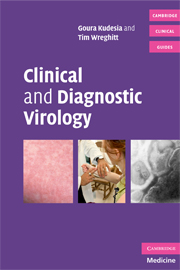Book contents
- Frontmatter
- Contents
- List of plates
- Preface
- Acknowledgements
- SECTION 1 INDIVIDUAL VIRUSES
- Introduction to virology
- 1 Adenoviruses
- 2 Arboviruses and haemorrhagic fever viruses
- 3 Cytomegalovirus (CMV)
- 4 Epstein–Barr virus (EBV)
- 5 Enteroviruses
- 6 Hepatitis A virus (HAV)
- 7 Hepatitis B and D viruses (HBV and HDV)
- 8 Hepatitis C virus (HCV)
- 9 Hepatitis E virus (HEV)
- 10 Herpes simplex virus (HSV)
- 11 Human immunodeficiency virus (HIV) and acquired immunodeficiency syndrome (AIDS)
- 12 Human herpes viruses types 6, 7 and 8 (HHV 6, 7 and 8)
- 13 Human T-cell leukaemia virus (HTLV)
- 14 Influenza viruses
- 15 Measles virus
- 16 Mumps virus
- 17 Noroviruses
- 18 Parainfluenza viruses
- 19 Papilloma and polyoma viruses
- 20 Parvovirus B19
- 21 Pox viruses
- 22 Rabies virus
- 23 Respiratory syncytial virus (RSV)
- 24 Rhinoviruses
- 25 Rotavirus
- 26 Rubella virus
- 27 SARS CoV and other coronaviruses
- 28 Varicella-zoster virus (VZV)
- SECTION 2 OTHER RELATED AGENTS
- SECTION 3 CLINICAL SYNDROMES
- SECTION 4 DIAGNOSTIC TECHNIQUES
- SECTION 5 PATIENT MANAGEMENT
- Index
- Plate section
26 - Rubella virus
Published online by Cambridge University Press: 07 December 2009
- Frontmatter
- Contents
- List of plates
- Preface
- Acknowledgements
- SECTION 1 INDIVIDUAL VIRUSES
- Introduction to virology
- 1 Adenoviruses
- 2 Arboviruses and haemorrhagic fever viruses
- 3 Cytomegalovirus (CMV)
- 4 Epstein–Barr virus (EBV)
- 5 Enteroviruses
- 6 Hepatitis A virus (HAV)
- 7 Hepatitis B and D viruses (HBV and HDV)
- 8 Hepatitis C virus (HCV)
- 9 Hepatitis E virus (HEV)
- 10 Herpes simplex virus (HSV)
- 11 Human immunodeficiency virus (HIV) and acquired immunodeficiency syndrome (AIDS)
- 12 Human herpes viruses types 6, 7 and 8 (HHV 6, 7 and 8)
- 13 Human T-cell leukaemia virus (HTLV)
- 14 Influenza viruses
- 15 Measles virus
- 16 Mumps virus
- 17 Noroviruses
- 18 Parainfluenza viruses
- 19 Papilloma and polyoma viruses
- 20 Parvovirus B19
- 21 Pox viruses
- 22 Rabies virus
- 23 Respiratory syncytial virus (RSV)
- 24 Rhinoviruses
- 25 Rotavirus
- 26 Rubella virus
- 27 SARS CoV and other coronaviruses
- 28 Varicella-zoster virus (VZV)
- SECTION 2 OTHER RELATED AGENTS
- SECTION 3 CLINICAL SYNDROMES
- SECTION 4 DIAGNOSTIC TECHNIQUES
- SECTION 5 PATIENT MANAGEMENT
- Index
- Plate section
Summary
The virus
Rubella virus is a single-stranded RNA virus, which is the only member of the genus Rubivirus within the family Togaviridae. The outer envelope protein E1 is the viral haemagglutinin protein responsible for binding to the cell receptors to initiate infection.
Epidemiology
Prevalence
Rubella has a worldwide prevalence. Before the introduction of vaccination, it circulated in epidemic form with an epidemic cycle every 6–8 years. In countries with effective childhood rubella vaccination programmes this pattern has been interrupted, as has been the number of reports of endemic cases. In countries without vaccination programmes it remains an infection of childhood. About 15–20% of young adults remain susceptible, putting them (especially pregnant women) at risk of acute infection as the virus is endemic and continues to circulate in the community.
Route of spread
Infection is spread via respiratory secretion droplets. The virus is highly infectious with attack rates of 50–80% in susceptible individuals in communities during outbreaks.
Incubation period
The rash usually develops 16–18 days after exposure, but the incubation period may range from 14–21 days. Infection is first initiated in the respiratory epithelium and then spreads and replicates in the regional lymph node. This is then followed by viraemia and dissemination of the virus to multiple sites.
Infectious period
Maximum viral shedding from the respiratory tract of infected individuals occurs from 5 days before to 7 days after the appearance of the rash.
- Type
- Chapter
- Information
- Clinical and Diagnostic Virology , pp. 109 - 112Publisher: Cambridge University PressPrint publication year: 2009



